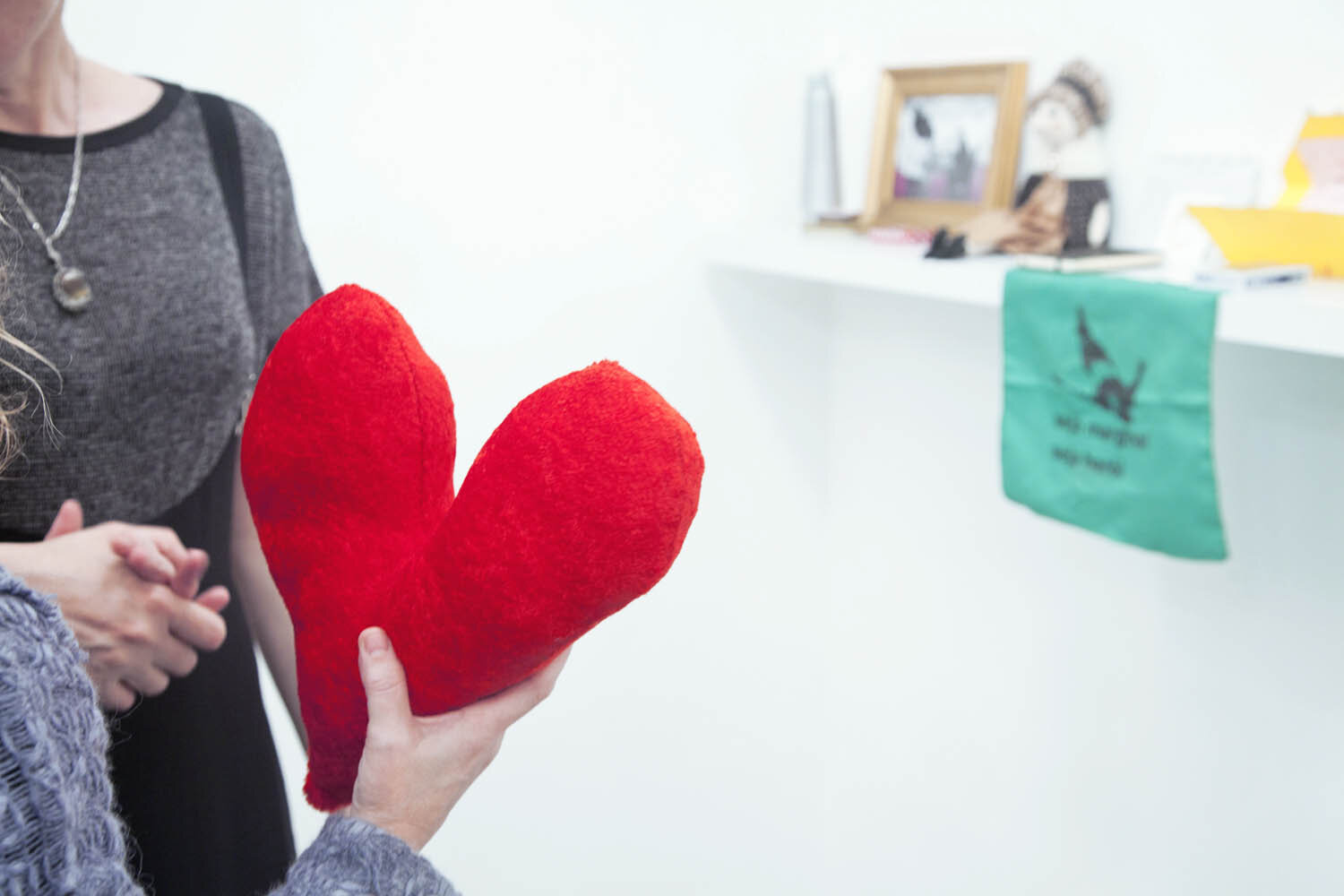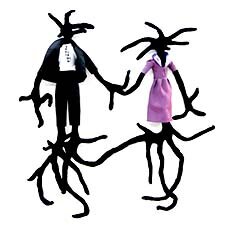2015
YOU/ME Solo Show
MUV Gallery, Rio de Janeiro, Brazil
"More love please". The phrase circulated for more than two years on the walls and streets of Rio de Janeiro. A calling, almost a cry for help, in banners and posters of the demonstrations of June 2013 that turned into a viral hashtag on social networks. If we could think of "More love, please" as a mantra, it would be a muttered soundtrack for YOU ME, Julia Csekö’s solo exhibition. "When love is most dangerous / is when it is sincere," Cacaso wrote in “Love love” (Amor Amor). There is a baffling and powerful sincerity in Julia’s proposal for this solo exhibition: the artist is willing to hand over her heart to whomever gives their own in return. Oh, and we're talking about abundance. Julia's heart comes in bunches, literally. A showy bunch of objects in shades of pink and red, handmade by the artist, takes the Gallery. O Only the bunch occupies the space, a plantation of love, the allegorical fabric hearts are available to those who bring something representing their own affection, their heart. Julia will hear who comes with the offer, and from the dialogue between hearts may appear a material exchange. Whomever has the heart-object accepted by the artist - the applicant must say why the object represented his affection, be it a box of candy, a notebook or something else - takes home a heart made by her. Thus, the exhibition at MUV Gallery will be constantly remade along its course, the public's affections will accumulate in the Gallery; and at the same time, the show will disintegrate, by means of the hearts being dispersed into the houses of the visitors to whom Julia has given her hearts to.
To love is to die a little, to dilute oneself in another and thus be enriched with the shock of differences. The wane of the original cluster and the occupation of the gallery with new objects, foreign to the initial design of the show, will demonstrate this constant instability that comes from experiences and encounters. Voilà mon coeur (Behold My Heart) is the name of an important work by Leonilson. This work of 1989 marks the passage of the artist into embroidery, crystals are stitched with gold thread in an ordinary canvas with fraying edges. The use of crystal and gold, alchemical raw materials, becomes a metaphor for the battered body - by then Leonilson already suffered complications arising from AIDS - a heart with regenerative capabilities, a way of transformation. The title, reference to the Catholic ritual of the Eucharist (This is my body, which shall be delivered for you; this is my blood which is given for you) also makes the heart a kind of communion. The affection for food. Communion is one of the forms proposed by the religare in religion. The first communion, the Supper of Christ and his disciples, the bread was distributed among them. From the breaking of bread came a word that today sounds anachronistic, but perhaps more than necessary these days: companion.
Julia symbolically divides the bread, willing to distribute the results of her work, sharing affection. Open to become the companion of every visitor that invests in the same direction, the artist confers materiality and physicality to these interactions, in midst of fleeting virtuality of these days. To exchange hearts magnetizes the exhibition space with this flood of emotion, with an energy exchange. It is crucial to remember the work of Ernesto Neto as a powerful engine of this work. Affiliated to the family of Naves and Neto’s fabric bodies, YOU ME transforms the Gallery itself into a heart: the flow of exchanges emulates circulation, with the back-and-forth of the blood irrigating every area of the body with energy.
Julia was interested in The Banquet, by Plato, when she began to think of this show. In the text, Eros, the god of love, appears not as the embodiment of what is good and well meaning, but as the movement that can lead to good. And is not that which Julia is proposing in this exchange of affections? In bartering objects there is the traffic that can bring change, reinventing places, time and practices from experiences. YOU ME is an anti-inertia reminder, so the cocoon of certainties and solitude that accompany our virtual existence may give rise to real encounters. Life can only radiate from an active heart.
Daniela Name 2015

















































































Coupling Hybrid
Coquetel, Castelinho do Flamengo, Rio de Janeiro, Brazil
This sculpture is a deep dive into banal and common things, questioning everything that is assumed to be natural, from reproduction to the idea of genders.
I am interested in playing with the familiarity of certain objects and symbols, such as clothes, and their varying degrees of importance in social hierarchies.
The viewer is invited to question very basic social symbols, such as a dress or a suit. The dress and suit until very recently synthesized ideas of femininity and masculinity. A suit is commonly associated with positions of power, social status, and stability, while a dress refers to the reproductive body, fertility, motherhood.
In this Coupling sculpture, the dress covers an unrecognizable body formed by tentacles that sprawl in several directions, made familiar by the recognizable symbol of feminine clothing. The large body is connected to two equally strange small bodies, once again wearing the familiar symbols of a dress and suit, only in miniature scale.
It is not clear which body originates from which. The large female body can be seen as replicating, a self-sufficient body, from which other beings emerge, or the miniature bodies may have created a larger being from their union. There is no clear logic defined.
The magenta velvet in these sculptures further distances us from what we expect to see inside clothing and from what is expected from the gender coding of clothing. It’s as if the insides poured out, and the body could be represented as an entanglement of viscera, rather than skin and limbs. The Coupling Replicating Hybrid presents us with familiar garments and social coding, covering the more obscure and mysterious aspects of existence, we are more than the garments that cover us - that is certain.
I invite the viewer to question the superficial familiarity, and ask not how, but why.
The sprawling bodies in these sculptures make room to question the social constructs that bind and limit self-expression in social interactions.
Julia Csekö







